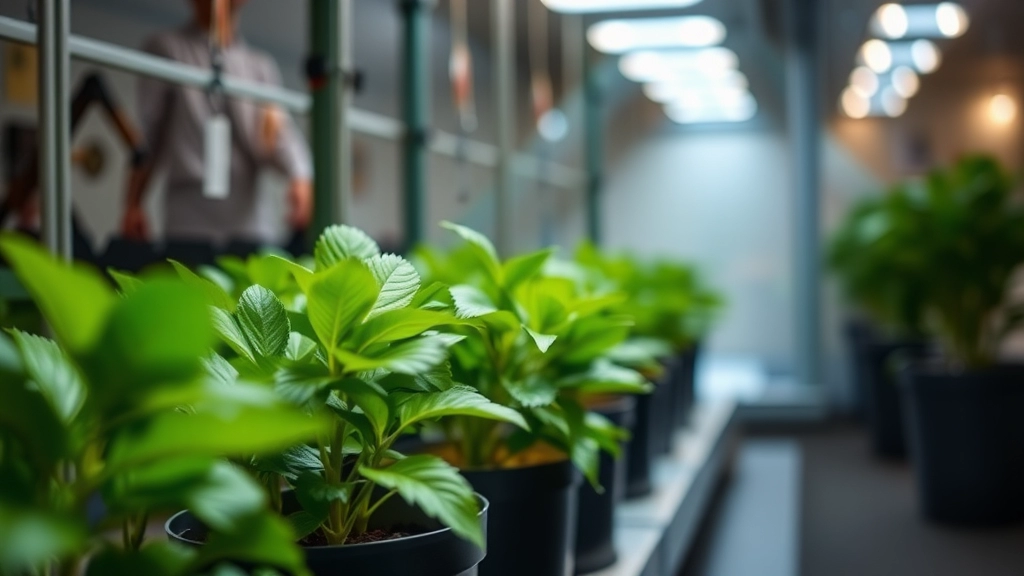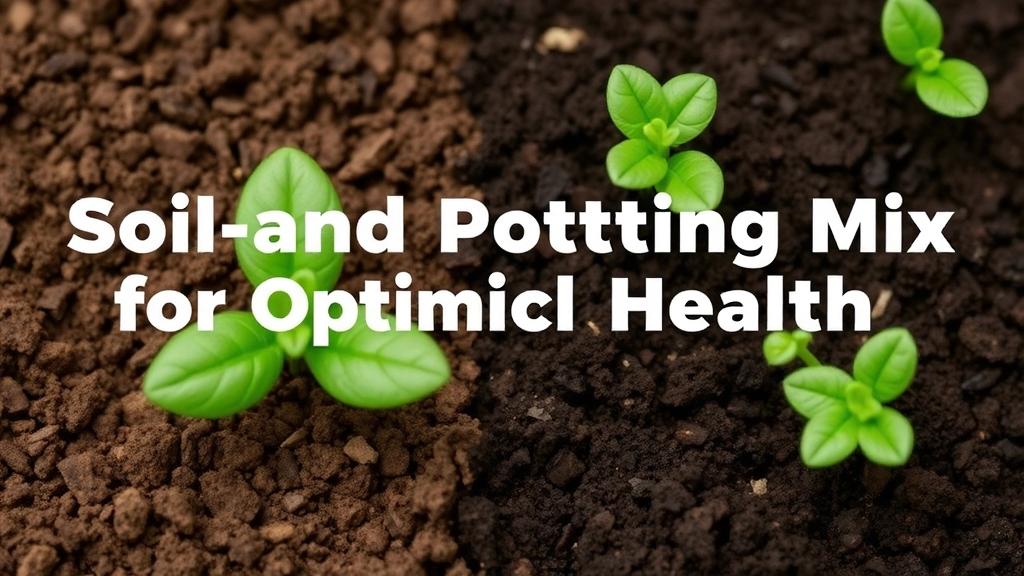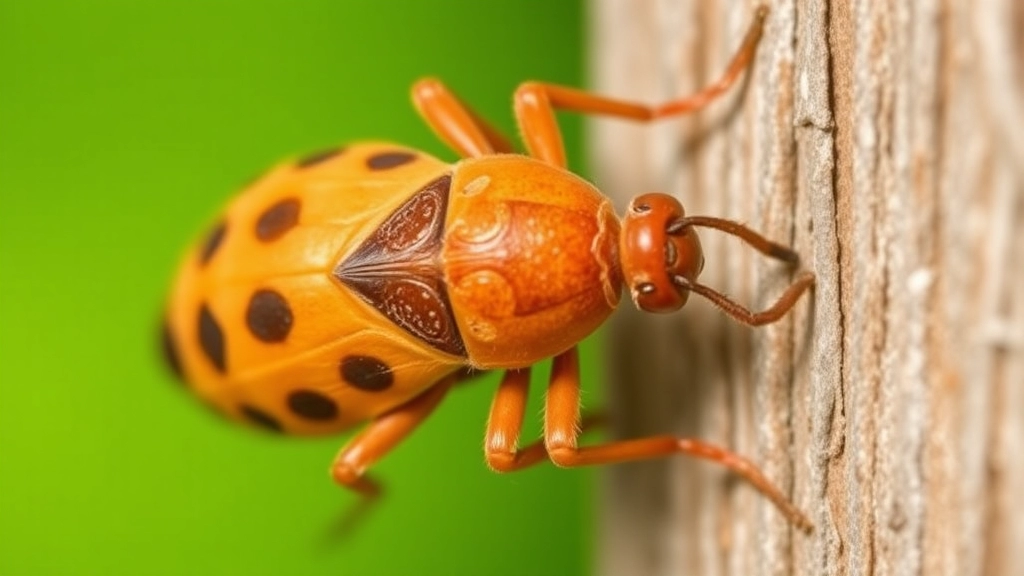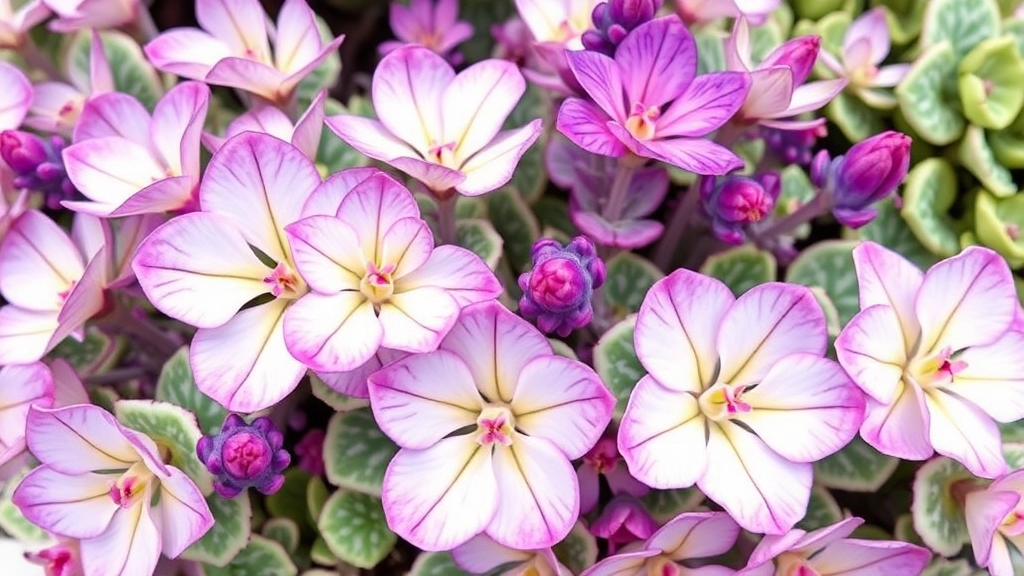Kalanchoe Lavender Scallops Variegated
If you’re captivated by the unique beauty of succulents, Kalanchoe Lavender Scallops Variegated is a must-have for your collection. This stunning variety stands out with its vibrant hues and intricate patterns. Whether you’re a seasoned gardener or just starting, understanding the specific care requirements of this plant will ensure it thrives in your home or garden.
Care Requirements
To keep your Kalanchoe Lavender Scallops Variegated healthy, you’ll need to provide the right light conditions, watering schedule, and soil mix. This guide will walk you through everything from ideal light exposure to propagation methods, ensuring your plant remains a showstopper. Let’s dive into the essentials of growing and maintaining this eye-catching succulent.
Characteristics of Kalanchoe Lavender Scallops Variegated
Have you ever wondered what makes Kalanchoe Lavender Scallops Variegated stand out among other succulents?
This charming plant is known for its striking, scalloped leaves that display a stunning blend of green and cream.
Unique Features
- Leaf Shape: The leaves are thick, fleshy, and have a distinctive scalloped edge, giving them an almost wave-like appearance.
- Variegation: The cream and green variegation adds a touch of elegance, making it a popular choice for indoor gardens.
- Growth Habit: It typically grows upright, reaching heights of around 30 to 45 cm, making it a lovely focal point in any space.
- Flowers: When in bloom, it produces clusters of small, tubular flowers that can range in colour from pink to red, adding an extra dimension of beauty.
Care Requirements
To keep your Kalanchoe Lavender Scallops thriving, understanding its characteristics is crucial.
This plant is relatively low-maintenance, making it perfect for both novice and experienced gardeners alike. For more detailed guidance, check out our Kalanchoe Lavender Scallops care guide.
If you’re interested in other varieties, you might also like to explore the Blue Kalanchoe succulent care guide.
Ideal Light Conditions for Growth

So, you’ve got your Kalanchoe Lavender Scallops Variegated, and now you’re wondering about the best light conditions for it to thrive, right?
This plant loves bright, indirect sunlight.
Here’s the lowdown on light needs:
- Bright Indirect Light: Place it near a window where it can soak up that lovely light without getting scorched.
- Avoid Direct Sunlight: Too much direct sun can lead to leaf burn.
- Morning Sun: A bit of gentle morning sun is actually great. It helps the plant grow without overwhelming it.
- Artificial Light: If you’re in a dimmer space, consider using grow lights. They can mimic natural light beautifully.
You want to keep an eye on your plant. If the leaves start to stretch or turn yellow, it might be a sign it’s not getting enough light.
On the flip side, if the leaves are crispy or brown, it’s likely getting too much.
Finding that sweet spot can take a bit of trial and error, but it’s worth it!
Watering Requirements and Frequency
One of the most common concerns for Kalanchoe Lavender Scallops Variegated enthusiasts is getting the watering right.
How often should I water my Kalanchoe?
Understanding the watering needs of this stunning succulent is crucial for its health. Kalanchoe Lavender Scallops thrive in a well-draining environment, and overwatering can lead to root rot, while underwatering can cause leaves to shrivel.
- Soil Moisture Check: Always check the top inch of soil. If it feels dry, it’s time to water.
- Watering Frequency:
- In the growing season (spring and summer), you may need to water every 1-2 weeks.
- During the dormant months (autumn and winter), reduce frequency to every 2-4 weeks.
- Watering Technique:
- Water thoroughly until it drains out of the pot’s bottom.
- Ensure no water sits in the saucer to prevent root rot.
- Environmental Factors:
- Factors like temperature and humidity can affect how quickly the soil dries out.
- In warmer, drier conditions, you may need to water more frequently.
By keeping these tips in mind, you’ll ensure your Kalanchoe Lavender Scallops Variegated remains vibrant and healthy. For more detailed advice, check out our optimal watering tips for healthy florist Kalanchoe. Additionally, understanding the causes of leaf discoloration can help you maintain the plant’s overall health.
Soil and Potting Mix for Optimal Health

When it comes to ensuring the vibrant health of your Kalanchoe Lavender Scallops Variegated, the right soil and potting mix are essential. You might be wondering, “What type of soil will help my plant thrive?” This section will guide you through the best options.
Ideal Soil Composition
Kalanchoe plants prefer a well-draining soil mix. Here’s what to look for:
- Cactus or Succulent Mix: These mixes are specifically formulated to provide excellent drainage.
- Perlite or Pumice: Adding these materials can enhance aeration and drainage.
- Organic Matter: A small amount of compost can provide essential nutrients without retaining too much moisture.
Potting Mix Recipe
If you want to create your own potting mix, consider this simple recipe:
- 2 parts cactus soil
- 1 part perlite
- 1 part compost
This combination ensures that your Kalanchoe Lavender Scallops has the right balance of drainage and nutrients.
Choosing the Right Pot
The choice of pot also plays a significant role in the health of your plant. Here are some tips:
- Terracotta Pots: These are excellent for succulents as they allow moisture to evaporate quickly.
- Drainage Holes: Always opt for pots with drainage holes to prevent waterlogging.
Signs of Poor Soil Health
Keep an eye out for these indicators that your soil may not be optimal:
- Yellowing Leaves: This can indicate overwatering or poor drainage.
- Root Rot: A foul smell or mushy roots signifies that the soil retains too much moisture.
In summary, using a well-draining potting mix and the right pot can significantly enhance the growth of your Kalanchoe Lavender Scallops Variegated.
Propagation Methods: Seeds, Cuttings, and Plantlets
When considering how to expand your collection of Kalanchoe Lavender Scallops Variegated, you might wonder about the best propagation methods. This succulent is not only beautiful but also relatively easy to propagate, making it a rewarding plant for both beginners and seasoned gardeners.
Propagation Methods
- Seeds
- Start by obtaining high-quality seeds from a reputable source.
- Sow the seeds in a well-draining potting mix.
- Lightly cover them with soil and mist gently to keep the moisture.
- Place the pot in a warm, bright location but avoid direct sunlight.
- Germination usually takes a few weeks, so patience is key.
- Cuttings
- Choose a healthy leaf or stem from an existing plant.
- Allow the cutting to dry for a day or two until the cut end calluses.
- Dip the cut end in rooting hormone to boost growth.
- Plant the cutting in a suitable potting mix, ensuring it’s well-draining.
- Water sparingly until roots develop, which may take a few weeks.
- Plantlets
- Kalanchoe Lavender Scallops often produces small offsets or plantlets around the base.
- Gently separate these from the parent plant, ensuring some roots are attached.
- Replant them in a pot filled with well-draining soil.
- Water lightly and provide bright, indirect light to encourage growth.
By mastering these propagation techniques, you can easily increase your Kalanchoe collection or share them with friends. For more detailed guidance, check out our Kalanchoe Tomentosa Propagation Guide and learn how to grow Kalanchoe from cuttings.
Common Pests and How to Prevent Them

So, you’ve got your Kalanchoe Lavender Scallops Variegated thriving, but what happens when those pesky pests come knocking?
Pests to Watch Out For:
- Mealybugs: These little white fluff balls love to hide in the leaf joints. They suck the sap and can cause stunted growth.
- Spider Mites: Tiny and often invisible to the naked eye, they leave fine webbing on your plant. If you notice yellowing leaves, they might be the culprits.
- Aphids: Small green or black bugs that cluster on new growth. They can be a real nuisance and spread diseases.
- Fungus Gnats: These annoying little flies hover around the soil. Their larvae can damage roots, especially in damp conditions.
Prevention Tips:
- Regular Inspections: Make it a habit to check your plants weekly. Look under leaves and in nooks where pests like to hide.
- Keep It Clean: Dust and debris can attract pests. Wipe down leaves with a damp cloth to keep them shiny and healthy.
- Proper Watering: Overwatering can lead to fungus gnats. Ensure your plant has well-draining soil and only water when needed.
- Neem Oil: This natural pesticide is a game-changer. Spray it on your plant at the first sign of trouble to deter pests without harming your plant.
- Isolation: If you bring a new plant home, keep it separate for a few weeks. This way, you can monitor for any pests before introducing it to your collection.
### VII. Fertilization Tips for Better Growth
As we delve into the care of Kalanchoe Lavender Scallops Variegated, one crucial aspect to consider is fertilization. Many plant enthusiasts often wonder how to give their plants the nutrients they need without overdoing it.
#### Understanding Nutritional Needs
Kalanchoe Lavender Scallops Variegated thrives when provided with the right balance of nutrients. Here are some key points to keep in mind:
Best Practices for Repotting and Transplanting Kalanchoe Lavender Scallops Variegated

So, you’re thinking about repotting your Kalanchoe Lavender Scallops Variegated? Great choice! Repotting can give your plant a fresh start and provide it with the space it needs to thrive. But how do you go about it without stressing your plant out?
When to Repot:
- Every 1-2 years: This is usually the sweet spot.
- Signs of root-bound: If roots are poking out of the drainage holes, it’s time.
- Soil degradation: If the soil looks compacted or has lost nutrients, repotting is a must.
Steps for Repotting:
- Choose the Right Pot:
- Make sure it’s slightly larger than the current one.
- Ensure it has good drainage holes.
- Prepare the Soil:
- Use a well-draining potting mix, ideally a cactus or succulent blend.
- You can mix in perlite or sand to improve drainage.
- Remove the Plant:
- Gently squeeze the pot to loosen the soil.
- Carefully pull the plant out, holding it by the base to avoid damage.
- Inspect the Roots:
- Trim any dead or rotting roots.
- If the roots are tightly wound, gently tease them apart.
- Repotting:
- Place a layer of fresh soil in the new pot.
- Position the plant in the centre and fill in around it with more soil.
- Press down lightly to eliminate air pockets.
- Watering Post-Repotting:
- Wait a few days before watering to let the roots settle.
- When you do water, ensure it’s thorough but not soggy.
Transplanting Tips:
- If you’re moving your plant to a new location, keep its environment consistent.
- Avoid exposing it to direct sunlight right after transplanting; let it adjust.
Repotting doesn’t have to be daunting. With these simple steps, you’ll have your Kalanchoe Lavender Scallops Variegated set up for success in no time!
Understanding the temperature and humidity needs of Kalanchoe Lavender Scallops Variegated is crucial for ensuring its health and vibrancy.
Many plant enthusiasts often wonder: What temperature range is best for my Kalanchoe?
### Ideal Temperature Range:
– **Daytime:** 20°C to 25°C (68°F to 77°F)
– **Nighttime:** 10°C to 15°C (50°F to 59°F)
Keeping your plant within this range will help it thrive.
### Humidity Levels:
Kalanchoe Lavender Scallops Variegated prefers moderate humidity levels. Aim for:
– **40% to 60% humidity**
This can be achieved through occasional misting or by placing a humidity tray filled with water near the plant.
### Tips for Maintaining Temperature and Humidity:
– **Avoid Drafts:** Keep your plant away from open windows and air conditioning vents.
– **Use a Thermometer:** Monitor the temperature regularly to ensure it remains within the ideal range.
– **Humidity Monitor:** Consider using a hygrometer to keep tabs on humidity levels.
By creating an environment that mimics its natural habitat, you can encourage robust growth and stunning foliage. For more detailed tips, check out this [complete care guide for Kalanchoe Chocolate Soldier](https://planthq.org/complete-care-guide-for-kalanchoe-chocolate-soldier/) and if you are curious about the lifespan of Kalanchoe, read our article on [how long does Kalanchoe live](https://planthq.org/how-long-does-kalanchoe-live-lifespan-care-tips/).
FAQs About Kalanchoe Lavender Scallops Variegated
What is the ideal light condition for Kalanchoe Lavender Scallops Variegated?
This plant thrives in bright, indirect sunlight. It should be placed near a window where it can receive ample light without being exposed to direct sunlight, which can cause leaf burn. A bit of gentle morning sun is beneficial, and artificial grow lights can be used in dimmer spaces.
What type of soil is best for Kalanchoe Lavender Scallops Variegated?
Kalanchoe Lavender Scallops Variegated prefers a well-draining soil mix. A cactus or succulent mix is ideal, and adding perlite or pumice can improve aeration and drainage. A small amount of compost can provide essential nutrients without retaining too much moisture.
How often should I repot my Kalanchoe Lavender Scallops Variegated?
Repotting is recommended every 1-2 years. Signs that your plant needs repotting include roots poking out of the drainage holes or soil that looks compacted or has lost nutrients.
What are common pests that affect Kalanchoe Lavender Scallops Variegated?
Common pests include mealybugs, spider mites, aphids, and fungus gnats. Regular inspections, keeping the plant clean, proper watering, and using natural pesticides like neem oil can help prevent these pests.
How can I prevent pests on my Kalanchoe Lavender Scallops Variegated?
Preventing pests involves regular inspections, keeping the plant clean, ensuring proper watering, and using natural pesticides like neem oil. Isolate new plants for a few weeks to monitor for pests before introducing them to your collection.
What are the signs of poor soil health in Kalanchoe Lavender Scallops Variegated?
Indicators of poor soil health include yellowing leaves, which can signify overwatering or poor drainage, and root rot, indicated by a foul smell or mushy roots. These issues suggest that the soil retains too much moisture.
What steps should I follow when repotting Kalanchoe Lavender Scallops Variegated?
Follow these steps for repotting:
- Choose a slightly larger pot with good drainage holes.
- Prepare a well-draining potting mix, ideally a cactus or succulent blend with added perlite or sand.
- Gently remove the plant from its current pot and inspect the roots, trimming any dead or rotting ones.
- Place a layer of fresh soil in the new pot, position the plant, and fill in around it with more soil, pressing down lightly to eliminate air pockets.
- Wait a few days before watering to let the roots settle. When you do water, ensure it’s thorough but not soggy.
What should I consider when choosing a pot for Kalanchoe Lavender Scallops Variegated?
Choose terracotta pots as they allow moisture to evaporate quickly and always opt for pots with drainage holes to prevent waterlogging.
How do I know if my Kalanchoe Lavender Scallops Variegated is getting too much or too little light?
If the leaves start to stretch or turn yellow, it might be a sign of insufficient light. On the other hand, if the leaves are crispy or brown, it’s likely getting too much light. Finding the right balance may take some trial and error.
References
-
How to Grow Kalanchoe Indoors – The Spruce
-
Kalanchoe Care: Tips For Growing Kalanchoe Plants – Gardening Know How
-
Kalanchoe: How to Grow and Care for Kalanchoe Plants – The Old Farmer’s Almanac
